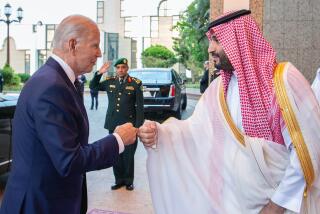U.S. Forces Test Combat Skill in Desert Exercises
- Share via
EASTERN SAUDI ARABIA — As diplomats plan the final details for meetings portrayed as the “last best chance” for peace, U.S. forces in Saudi Arabia are preparing for war by stepping up their tactical training and live-fire exercises.
The desert exercises rely heavily on armor and are designed to take the initiative and counter the type of war that the numerically superior Iraqis would be expected to fight.
Marine units have built defensive fortifications and berms in the desert similar to those used by Iraq, then stormed them, often at night, with armor and troops.
Military police platoons are practicing urban assault and building-clearing techniques that they would use if they attempted to liberate Kuwait. The Army’s 63rd Chemical Company is training soldiers in the basics of decontamination. Military hospitals are running mock casualty drills.
With U.S. troops from Germany pouring into Dhahran, capital of Saudi Arabia’s oil-rich Eastern province, the Defense Department appears eager to publicize the story of the buildup and the intensified training.
The 350 journalists who have descended on the desert kingdom no longer find their access limited to U.S. field units, as they did after Thanksgiving. They are now offered daily trips by the U.S. military to Marine and Army training exercises, Air Force facilities and Navy aircraft carriers.
When the 1st Battalion of the 7th Marines heard on Armed Forces Radio last week that Iraqi President Saddam Hussein had ordered the freeing of Western and Japanese hostages in Kuwait and Iraq, there were high-fives and shouts of elation. “That’s one battle won without firing a shot,” said one of the Leathernecks.
“Everyone got psyched, hoping things were getting settled,” said Lt. David Devore of Frederick, Md. “But we’ve got to maintain our edge. Everyone realizes that war is still imminent, that it’s still possible.”
The next morning, the battalion commander, Col. Jim Matthis, told his troops: “This guy, Saddam Hussein, is a master at raising world hopes for peace, then dashing those hopes. Be a little skeptical. If things go wrong, we’ve still got a heck of a job to do in front of us.”
Then, he took his battalion into the heart of the Arabian desert for a three-day exercise against mock Iraqi defenses. Although his troops had trained daily, it was only the third time they had fired live ammunition in the last two months.
Each company had managed to get hold of only one map, and the featureless terrain, marked by little more than shifting sand dunes, presented navigation problems, as it would in actual combat, for the drivers of the armored personnel carriers.
Matthis’ troops had arrived in Saudi Arabia in August from March Air Force Base in California expecting immediate combat. That adrenaline rush has since given way to the simple recognition that preparation is the best guarantor of survival.
“These guys have really surprised me with their ability to stay focused on the mission,” Matthis said. “I can see them improve in just a day on an exercise like this. Right now, they’re sharp and focused, but if you stay out here long enough, at some point you peak and lose your edge. I’d say if we had to be here nine to 12 months, it would start costing us.”
Over and over, they assaulted a mock Iraqi position 1,200 yards away, their .50-caliber machine guns kicking up sparks on the targeted oil drums. They dashed out of their 40-m.p.h. tracked carriers, crawling across dunes on elbows and knees.
They broke only to eat their pouches of freeze-dried food and to puff on a cigar or take a pinch of snuff--habits that seem to have replaced the cigarettes everyone smoked in Vietnam.
Then they began again.
More to Read
Sign up for Essential California
The most important California stories and recommendations in your inbox every morning.
You may occasionally receive promotional content from the Los Angeles Times.












